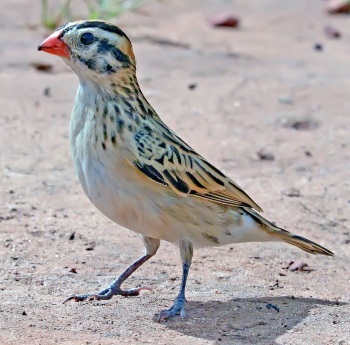- Vidua macroura
Identification
11–12 cm (4¼-4¾ in) in length, tail an additional 20cm
Adult male
- Black back and crown
- Long black tail
- White patches on dark brown wings
- White underparts and head
- Red bill
The female and non-breeding male:
- Streaked brown upperparts
- Whitish underparts
- Buff flanks
- Buff and black face pattern
- They lack the long tail extension
Distribution
Africa south of the Sahara Desert:
Western Africa: Mauritania, Senegambia, Senegal, The Gambia, Guinea-Bissau, Guinea, Mali, Sierra Leone, Liberia, Ivory Coast, Burkina Faso, Ghana, Togo Benin, Nigeria, Niger, Niger, Chad, Cameroon, Central African Republic, Equatorial Guinea, Gabon, Democratic Republic of Congo, Angola, Zaire
Eastern Africa: Sudan, South Sudan, Eritrea, Ethiopia, Somalia, Kenya, Uganda, Rwanda, Burundi, Tanzania, Zambia, Mozambique, Malawi
Southern Africa: Namibia, Botswana, Zimbabwe, South Africa, KwaZulu-Natal, Lesotho, eSwatini
African Islands: Gulf of Guinea Islands: Bioko (Fernando Po), Sao Tome
Feral population occur in Puerto Rico, Singapore, and California.
Taxonomy
This is a monotypic species[1]., however, a second subspecies arenosa is sometimes recognized.
Habitat
Open grassland and shrubby areas, including open woodland, scrub, gardens and cultivation.
Behaviour
Diet
The diet consists mostly of small seeds which are gleaned from the ground. They also catch insects in flight.
The female may eat the eggs of the host species.
Breeding
They are a brood parasite laying their eggs in the nests of estrildid finches, especially waxbills. In South Africa, the primary host is Common Waxbill Estrilda astrild.
In Puerto Rico, only introduced species are parasitized, none of the native species. Their 2-4 white eggs are added to those already present in the nest.
References
- Clements, J. F., T. S. Schulenberg, M. J. Iliff, D. Roberson, T. A. Fredericks, B. L. Sullivan, and C. L. Wood. 2017. The eBird/Clements checklist of birds of the world: v2017, with updates to August 2017. Downloaded from http://www.birds.cornell.edu/clementschecklist/download/
- Avibase
- Handbook of the Birds of the World Alive (retrieved August 2016)
- Study of host species in South Africa
- Wikipedia
- BF Member observations
Recommended Citation
- BirdForum Opus contributors. (2024) Pin-tailed Whydah. In: BirdForum, the forum for wild birds and birding. Retrieved 16 April 2024 from https://www.birdforum.net/opus/Pin-tailed_Whydah
External Links
GSearch checked for 2020 platform.







